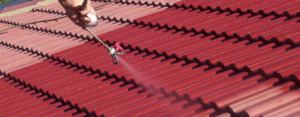Precipitation during the winter can be heavy at times and snow or rain will always hit your house. This can cause flooding through your roof or foundation, so the steps covered in previous sections can all help with the waterproofing process. There are also some other steps like digging drainage ditches, removing shrubbery near the home as well as planting shrubs on slopes toward your home to impede the flow of water. Other steps require professionals. Some waterproofing methods involve construction and handling chemicals or using roof waterproof paint. You can install an interior drainage system which must be done by a professional. While possible to treat your home with waterproofing chemicals, it is better left to professionals since they can be more thorough as well as get more effective chemicals than those available to the general public.
When installing an interior drainage system, the floor at the base of your foundation walls is dug up and drainage trenches are installed to control the flow of water. These drainage trenches often have gravel bases for better absorption and end at a sump pump that pushes water from the home. After the trench is installed and working properly, the floor can be re-installed over it. If you have block walls, you can also drill holes in the wall to lead directly to the interior drainage system. This will eliminate water problems in the basement.
Sealants or waterproof roof paint are another way to waterproof your basement. A common compound used in this process is called capillary waterproofing material. This sealant can be put on the interior or exterior walls and penetrates deep into the cement blocks. It forms crystals which prevent water from entering the concrete. Although you can apply it yourself, professionals will generally do a better job so it is a good idea to consider hiring a service company to do the work.
Make all the parts of the house waterproof:
Waterproofing should also be done in other areas of your home besides the foundation and basement. Windows can be sealed in the winter and doorways should fit snuggly in their frames to prevent rain or snow from entering. Chimneys and exhaust pipes in the roof should be sealed and the flues and caps should be inspected to make sure they work correctly. Moreover, roofs should be painted with the roof waterproof paint to prevent your roofs from mildew. A good solid coat of water-resistant paint will help a lot to keep water from entering your home. If you seal everything during the fall then you’ll have a warm and cozy winter.

